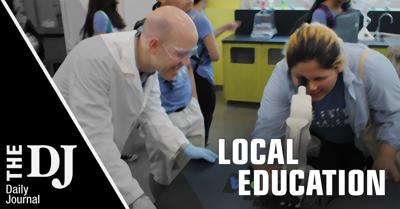Stark discrepancies and inadequacies of funding for school districts throughout high-cost San Mateo County was studied by the county’s Board of Education in hopes of understanding the impacts and developing a plan to address the concerns.
The state’s school funding system has structural inequities that result in disproportionate impacts to districts, despite all being located within the same county, the San Mateo County Board of Education’s task force concluded.
The task force — which included representatives from eight different school districts — convened over three meetings to address concerns on how districts are funded and what the county’s Office of Education can do to support them through legislative actions.
The task force’s discussions and considerations were presented in a report to the county’s Board of Education, which approved the report at its meeting Oct. 8. Trustees applauded the effort to bring the topic to light.
Board Vice President Beverly Gerard said uncovering the major discrepancies of districts in a county known to be wealthy is something many might not want to acknowledge. Gerard said it was critical to make the public aware of the reality.
“It really has brought a lot of attention to this particular subject and everybody knew it was there but not everybody wanted to talk about it,” Gerard said. “This has really gotten a lot of conversations going and people really realizing the inequities there are.”
In San Mateo County, around 90% to 95% of school revenue comes from property taxes, which means many districts are considered to be community funded, or basic aid districts, according to the task force’s report. In 2024-25, only five districts in the county were state-funded.
Some districts flip between funding designations because of supplemental taxes that are triggered with reassessed priorities, according to the task force’s report. This causes cash flow issues when districts can’t account for where their money will come from with enough advanced warning.
The impact of the state’s funding formulas and allocations results in staffing challenges, budget constraints and ultimately harmful impacts on students, the report concludes.
A key goal of the task force is to coordinate closely with state legislators, particularly state Sen. Josh Becker, D-Menlo Park, to imagine tangible ways to reimagine how districts throughout the county get their money.
The task force considered three possible areas of focus for legislation: address the high cost of living, utilize excess property taxes in a new way, and address housing needs for teachers.
One idea discussed by the task force was to introduce a cost-of-living adjustment to support the lowest funded districts in high-cost counties. The state’s funding formula does include a statewide yearly cost-of-living adjustment, but these increases are standard across the state and tend to not keep pace with inflation, the task force’s report concluded.
Another potential area of focus for legislation included enabling the county’s Office of Education to distribute excess property taxes back to districts, rather than back to the state.
Recommended for you
Trustee Susan Alvaro noted the frustrating nature of excess property taxes going back to the state. Alvaro described “the real thorn” is that excess property taxes — which are intended to direct property taxes to schools — instead go to noneducational uses.
The excess property taxes, not ERAF redistribution, is the focus of potential legislation, Office of Education spokesperson Ian Bain clarified.
In San Mateo County, only state-funded districts are affected by ERAF money. In 2024-25, ERAF collected $426 million in property taxes, but the state was only obligated to allocate $17 million to the county’ state-funded districts. Community-funded districts, or basic aid districts, don’t get ERAF money at a considerable rate. This means an excess of $409 million was redistributed through returned ERAF to local government agencies, rather than schools.
Changing affordability requirements for housing to better align with teacher salaries in high-cost districts was also discussed.
Addressing any of the three concerns with legislation will present its own set of potential hurdles or complications, but the task force and legislators are still committed to working on the effort, the report reads. This work will continue throughout the fall with hopes of introducing a bill to the legislature in 2026, according to the report.
The effort will be a long game, however.
“There was a shared understanding that this issue won’t be solved quickly,” the report reads, summarizing a conversation held during one of the task force’s convened meetings.
Two bills already under consideration at the state level are aimed at addressing funding inequities, on which the county’s Office of Education will keep a close eye.
Senate Bill 743 proposed a constitutional amendment to create an “educational equalization account” that hopes to close the per-pupil funding gap. Assembly Bill 477 also looks to set new base grant targets for school years 2036-37 to increase teacher salaries.
The discrepancies of per-pupil funding across districts within a wealthy county is not unique to San Mateo County. In Santa Clara County, for instance, Alum Rock Union School District funding is 25% less per pupil than the Saratoga Union School District’s.
The hope of the task force is to address the concern not only in San Mateo County, but in any high-cost county.
“I think it’s important for us to put our name behind this,” Alvaro said, before approving the report.































(0) comments
Welcome to the discussion.
Log In
Keep the discussion civilized. Absolutely NO personal attacks or insults directed toward writers, nor others who make comments.
Keep it clean. Please avoid obscene, vulgar, lewd, racist or sexually-oriented language.
Don't threaten. Threats of harming another person will not be tolerated.
Be truthful. Don't knowingly lie about anyone or anything.
Be proactive. Use the 'Report' link on each comment to let us know of abusive posts.
PLEASE TURN OFF YOUR CAPS LOCK.
Anyone violating these rules will be issued a warning. After the warning, comment privileges can be revoked.